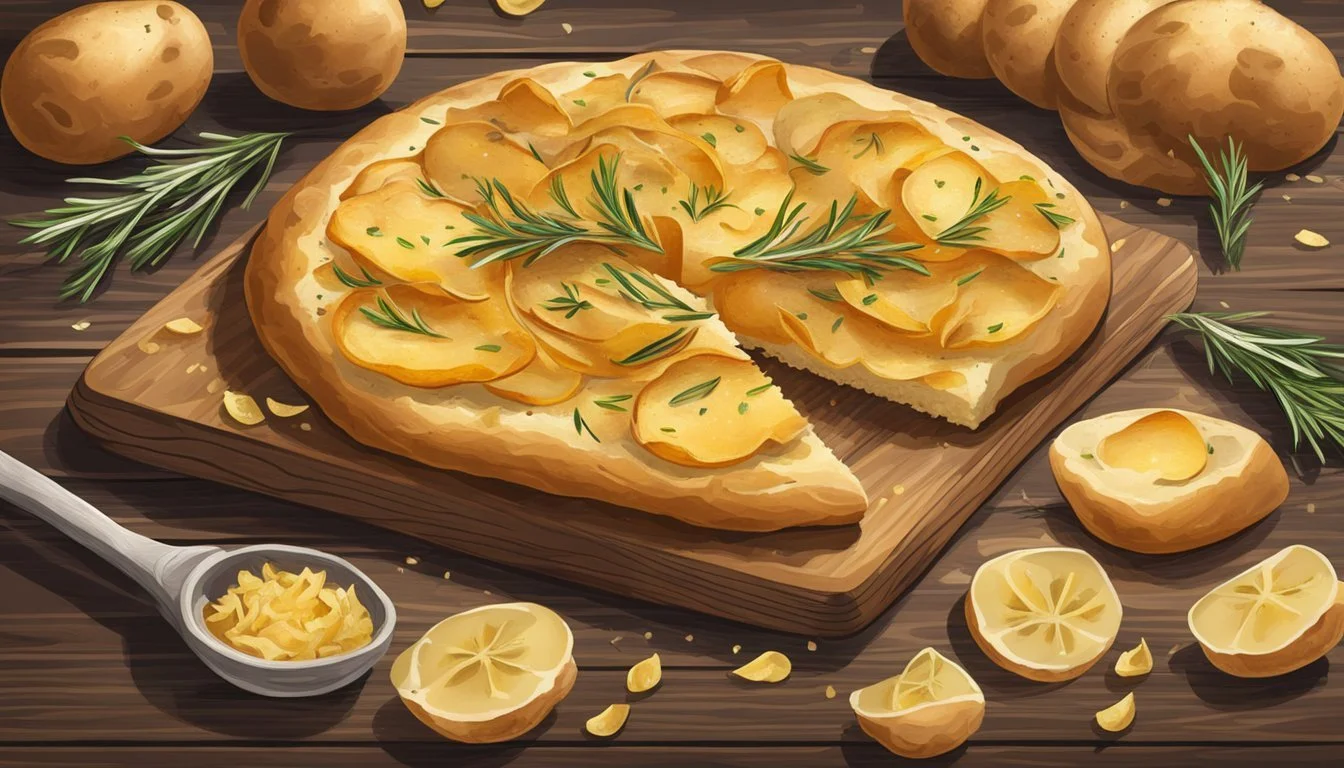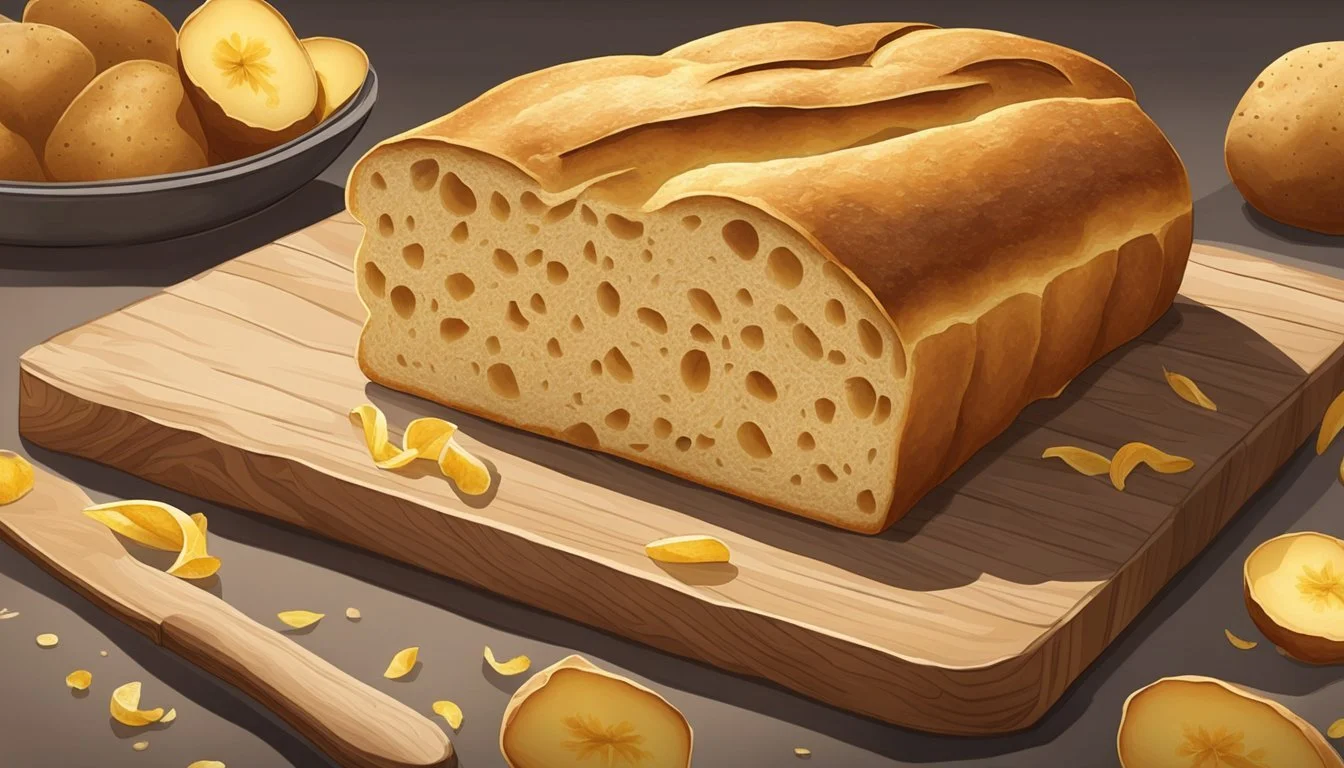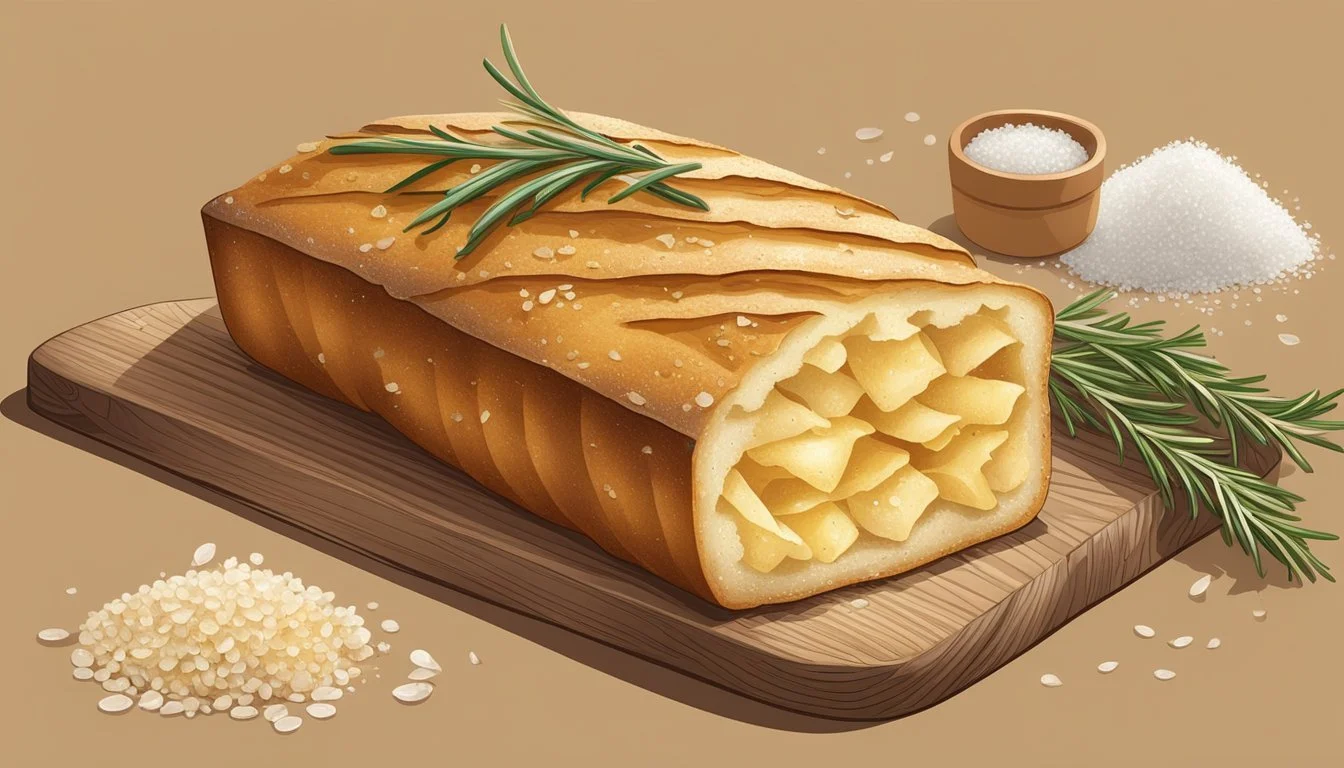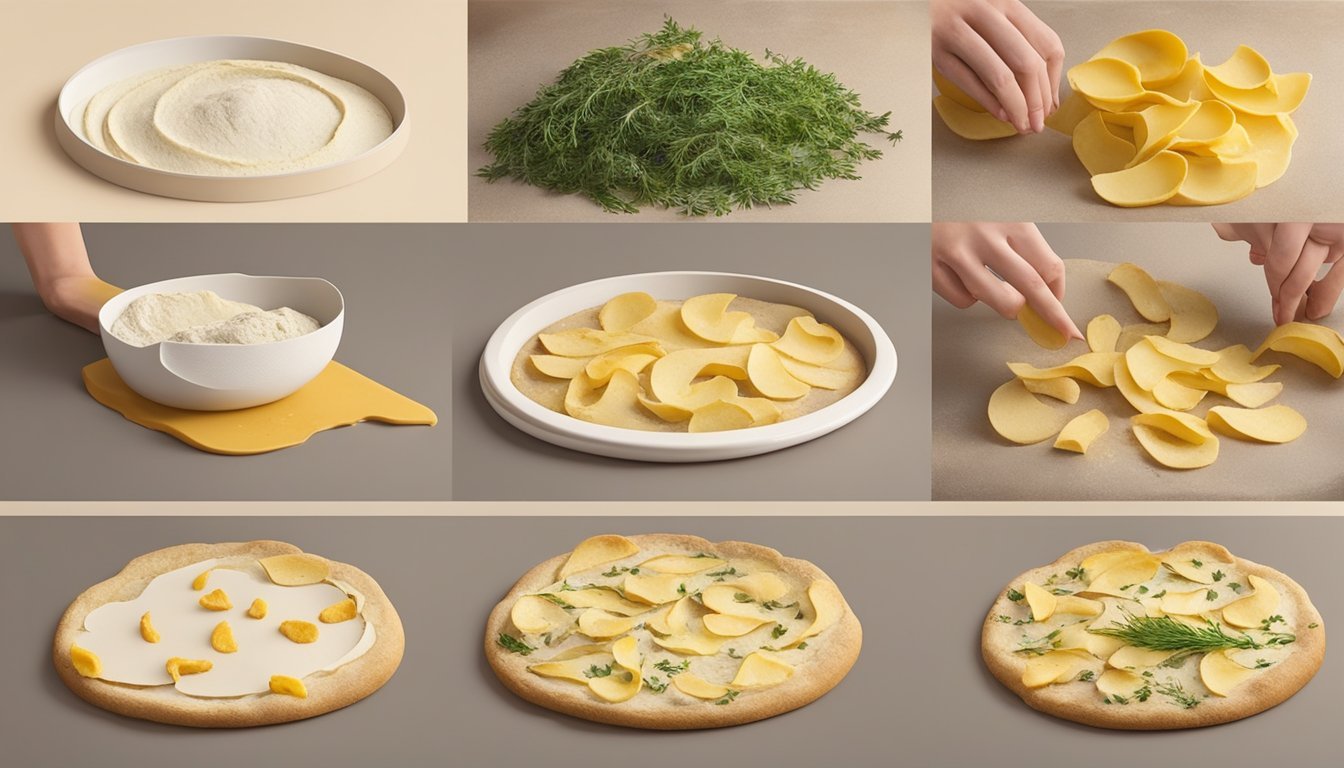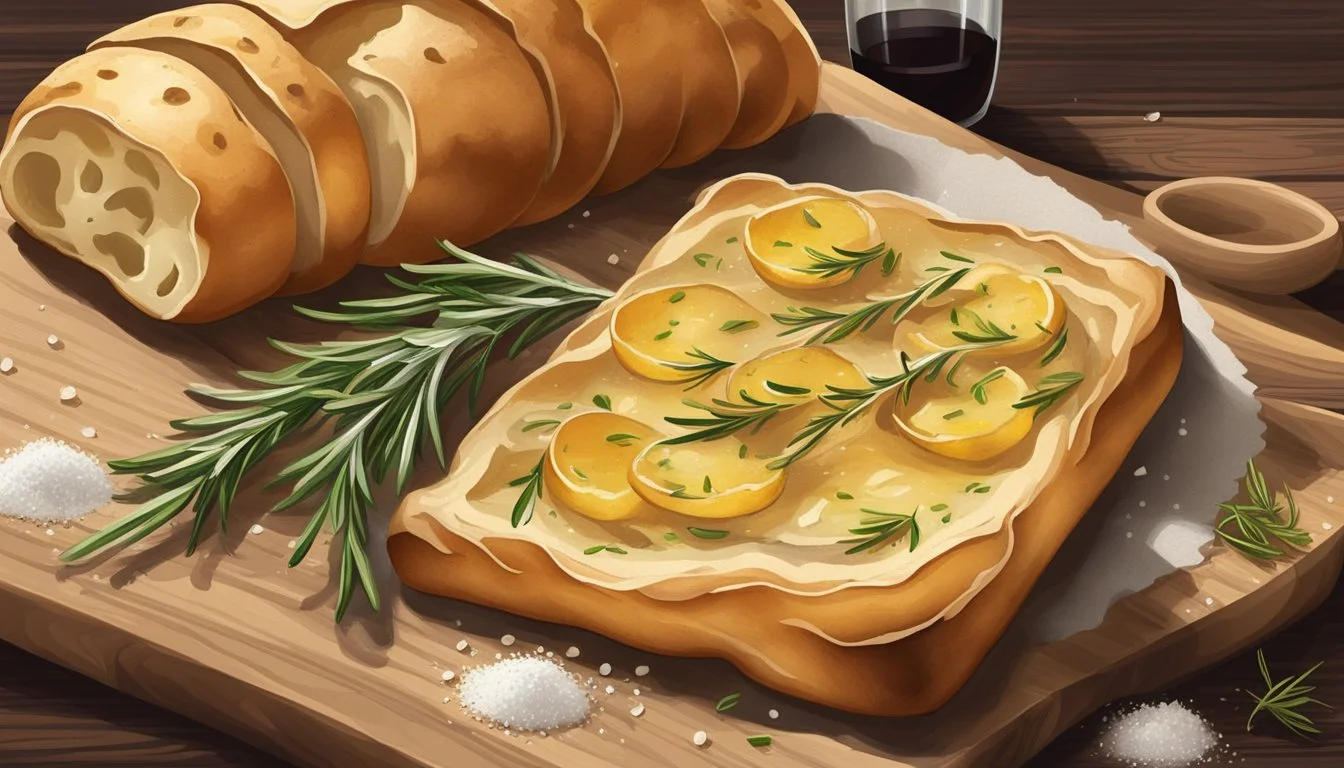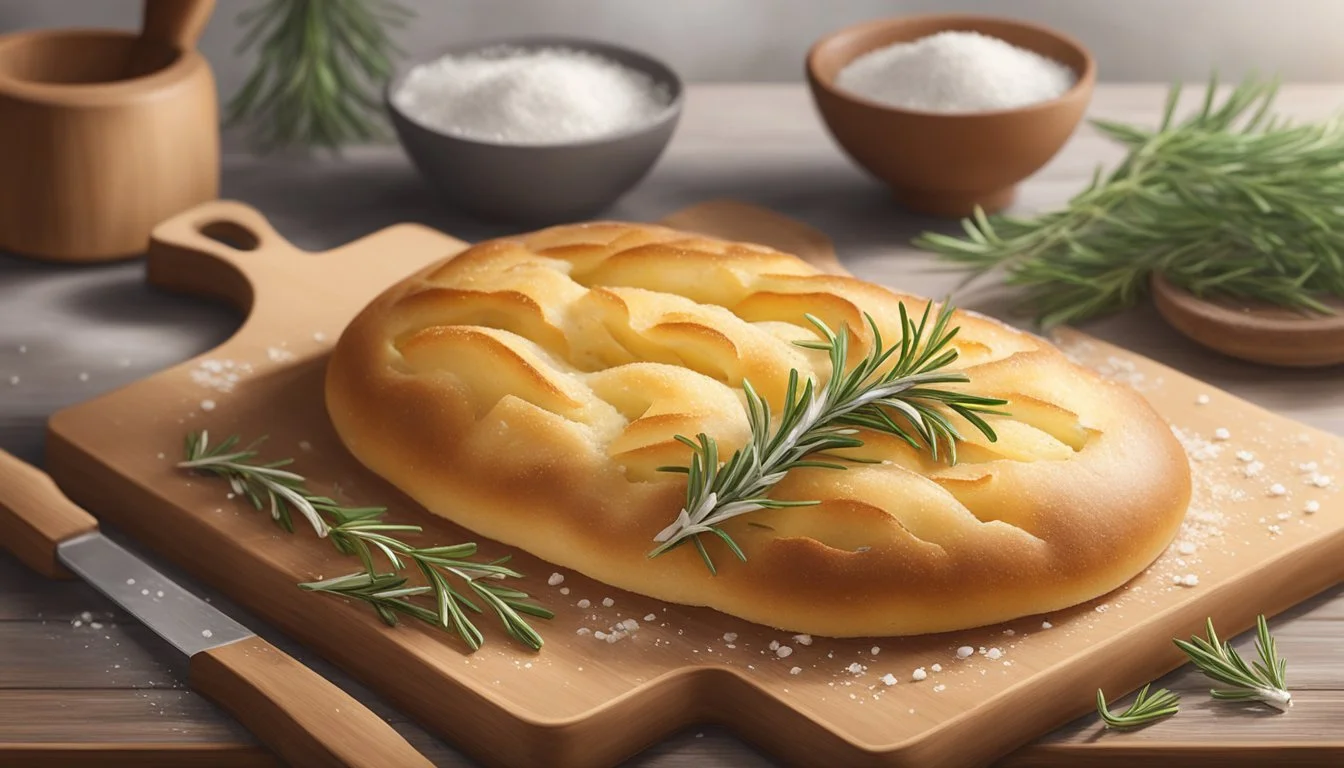Potato Peel Focaccia
Exploring the Crunchy Delight of Rustic Italian Bread
Potato Peel Focaccia represents a delightful twist on the traditional Italian bread, infusing a rustic charm into each bite. In a world where waste reduction is as relevant as the pursuit of culinary delight, this iteration of focaccia celebrates the often-overlooked potato peel. Used in the dough, potato peels not only impart an earthy flavor but also contribute to a pleasingly crispy texture, distinguishing it from its classic counterpart.
This variation of focaccia adheres to the principles of Italian cuisine—simplicity and quality. The bread integrates simple ingredients, a testament to the Italian culinary philosophy, where the focus lies in elevating the essence of each component. Potato Peel Focaccia is not a mere novelty; it embodies the ingenuity of Italian baking, where bakers have long been admired for their ability to create an array of breads from a core list of basic ingredients.
Bakers weave the humble potato peel into the fabric of the focaccia dough, transforming the typically discarded scraps into a feature ingredient that provides texture and flavor. This approach showcases the versatility within Italian bread-making and offers an invitation to explore the understated aspects of cuisine that often go unnoticed. While it carries the hallmarks of traditional focaccia—soft on the inside and lightly crisp on the outside—the inclusion of potato peels exemplifies a resourceful and sustainable culinary practice.
Background and Origin
The section reveals the rustic roots and evolution of Potato Peel Focaccia, tracing its journey from ancient traditions to a beloved Italian staple.
History of Focaccia in Italy
Focaccia, a renowned Italian bread, has a storied past deeply intertwined with the history of Italy itself. Focaccia's origins are speculated to be twofold: some suggest it began with the Etruscans in North Central Italy before the Roman times, while others attribute its conception to ancient Greece. Over time, the bread spread across the Italian peninsula, with different regions, including Puglia, adopting their unique versions.
The term focaccia is derived from the Latin word "panis focacius," implying bread baked under the ashes of a hearth. Historically, this method of cooking was a communal practice where families would gather around the fire.
Italian focaccia varies significantly by region: in Puglia, for instance, one can find focaccia topped with tomatoes, olives, (What wine goes well with olives?) and herbs. The curiosity of using potato peels in focaccia not only reflects a no-waste philosophy but also adds a distinct crispiness and flavor to the bread, ensuring every part of the potato is utilised. This adaptation represents the Italian culinary ethos of innovation within the boundaries of tradition, making focaccia a special delicacy passed down through generations.
Nutritional Profile
In approaching the nutritional landscape of Potato Peel Focaccia, one can anticipate a blend of carbohydrates from the flour and potato peels, as well as varying levels of dietary fiber. This profile often reflects a moderate caloric content and essential nutrients beneficial to a balanced diet.
Caloric Information
Potato Peel Focaccia typically has a moderate calorie count due to its primary ingredients: flour and potatoes. (What wine goes well with potatoes?) The caloric value can be further influenced by additional ingredients such as oils or toppings.
Average calories per serving (approximately 100g): 250-300 kcal
Macro Nutrient Breakdown
The macro nutrient composition of Potato Peel Focaccia is predominantly carbohydrates, with protein and fats present in smaller quantities. The presence of potato skins can slightly increase the fiber content, contributing to the nutritional richness of the bread.
Carbohydrates: 50-60g
Of which Fiber: 2-4g
Of which Sugars: 1-2g (naturally occurring)
Protein: 8-10g
Total Fat: 4-7g
Saturated Fat: less than 1g
Unsaturated Fat: balance of total fats
Sodium: 400-700 mg
Cholesterol: 0 mg (absent unless added ingredients contain it)
Potato Focaccia vs. Traditional
Potato Focaccia offers a unique twist to the traditional focaccia with its incorporation of potatoes, presenting variations in texture, flavor, and preparation.
Key Differences
Texture: Traditional focaccia is known for its chewy and airy crumb, thanks to the high hydration of the dough. In contrast, Potato Focaccia includes mashed or diced potatoes in the dough, which results in a more tender crumb and a crispy crust when baked.
Flavor: While traditional focaccia has a simple yet rich taste, often enhanced with olive oil and herbs like rosemary, Potato Focaccia carries the distinct, earthy undertones of potatoes that meld with the bread’s yeasty base.
Preparation: The preparation method for traditional focaccia involves a simple dough of flour, water, yeast, salt, and olive oil. The Potato Focaccia, however, requires the additional step of preparing potatoes – either boiled and mashed, or diced and incorporated into the dough.
Comparison with Pizza Dough:
Focaccia generally uses a thicker, more bread-like dough with a higher yeast and water content, resulting in a fluffy texture.
Potato Focaccia and pizza dough are distinct; while some pizza doughs may include potato flour for texture, potato focaccia actually incorporates potato as a key ingredient, diverging further from the crisp and stretchy base of a traditional pizza.
In summary, the key distinction between Potato Focaccia and traditional focaccia lies in the addition of potato, which transforms aspects of the bread’s texture, flavor, and preparation method. The inclusion of potato doesn't align with traditional pizza concepts, making it a unique bread in its own right.
Ingredients Overview
The Potato Peel Focaccia is a sumptuous combination of crisp textures and robust flavors, demanding specific ingredients to ensure its rustic charm. Here, each component is pivotal not just for taste but for the integrity of the bread's structure.
Flour Types
For the base of Potato Peel Focaccia, all-purpose flour is most commonly used due to its moderate protein content, which offers a delicate balance between chewiness and structure. The choice of flour impacts the texture significantly, so all-purpose flour is the go-to option for a tender crumb.
Choosing Potatoes
Potatoes are central to this focaccia variant, with mashed potatoes incorporated into the dough and potato peels often used as a topping. Opting for a starchy variety like Russet or Yukon Gold can enhance the bread's moistness.
Oils and Fats
Olive oil is essential, creating the focaccia's characteristic crisp crust and depth of flavor. It's used both in the dough and drizzled over the top before baking. High-quality extra virgin olive oil can add a peppery note.
Yeast and Salt Varieties
Active dry yeast is a critical agent, helping the dough rise and develop its airy texture. When it comes to salt, fine sea salt or kosher salt can be used in the dough for seasoning, while flaky sea salt may be sprinkled on top for crunch and flavor.
Additional Flavorings
Rosemary is a popular herb that infuses the bread with a fragrant, earthy tone. Other embellishments can include black pepper, thinly sliced onions, sun-soaked cherry tomatoes, or olives. Parmesan cheese offers a savory umami element when sprinkled atop before baking.
Preparation Techniques
In crafting the perfect Potato Peel Focaccia, meticulous attention to dough preparation is crucial. This includes proper kneading, allowing the dough to rise until it's perfectly fluffy, and topping with care to achieve a crispy golden-brown crust.
Kneading the Dough
One begins the focaccia journey by kneading a well-hydrated dough to ensure a fluffy interior texture. A stand mixer can be employed to knead flour, yeast, salt, honey, mashed potatoes, and oil, gradually adding water until the dough is smooth yet sticky. This typically takes 3-4 minutes. If kneading by hand, press and fold the dough until it reaches similar consistency, recognizing that this may extend the prep time.
Rising the Dough
After kneading, the dough requires ample rising time to develop airiness and flavor. The dough should be placed in a lightly oiled bowl, covered, and set aside in a warm spot. Here, patience is key, as the dough should be allowed to rise until it has doubled in size, which can take about 1 hour at room temperature.
Shaping and Topping
Once risen, the dough is coaxed into a rustic shape with a series of gentle stretches and transferred to a baking tray. Authentic Potato Peel Focaccia showcases a sprinkling of potato peels across its surface. The maker indents the dough with fingers or a handle of a utensil to create characteristic dimples. Before baking, a touch of oil may be applied to encourage a crispy, golden brown finish.
Cooking Instructions
In the preparation of Potato Peel Focaccia, precise temperature settings and vigilant cook time monitoring are key to achieving the desired crispy crust and soft interior. The following instructions ensure that one harnesses the oven's capabilities effectively for the best results.
Baking Temperatures
The oven must be preheated to a specific temperature to create the ideal baking environment for the focaccia. For Potato Peel Focaccia, an oven temperature of 375°F (190°C) is optimal. One should use the middle rack for even heat distribution, and if available, employ the convection setting to circulate air and encourage even browning. A properly calibrated oven is critical to prevent undercooking or burning.
Cook Time Monitoring
Focaccia requires attentive monitoring to achieve a golden brown surface without overbaking. The suggested cook time spans from 20 to 40 minutes depending on the recipe's specifics and the oven's peculiarities. It's best to check the bread periodically. One should look not only for the color but also for a crispy edge and a soft but cooked-through interior.
20-minute mark: Check for browning.
30-minute mark: Test for doneness with a skewer.
40 minutes: If necessary, extend cook time in 5-minute increments.
The Potato Peel Focaccia should be placed on a rimmed baking sheet or into a baking pan that has been lightly oiled or lined with parchment paper to prevent sticking. This ensures easy removal once the bread is baked to perfection.
By adhering to these guidelines, one is set to produce a Potato Peel Focaccia with the desired qualities of a rustic Italian bread: crisp edges, a golden hue, and a savory, tender bite.
Serving and Pairing Suggestions
When it comes to enjoying Potato Peel Focaccia, selecting the right accompaniments and beverages can elevate the experience. This rustic bread pairs well with a variety of dishes and can be enjoyed as a snack or as part of a larger meal.
Accompaniments
Potato Peel Focaccia is versatile and can complement many dishes. For a hearty lunch, the focaccia serves as an excellent base for a sandwich—its crispy crust and fluffy interior make it an ideal contrast to both rich and delicate fillings. On the simpler side, one might enjoy it as a snack, dipped into hummus or olive oil.
With Soup: A bowl of soup paired with a slice of focaccia makes for a comforting and satisfying meal.
Lunch Pairings:
Tomato and Mozzarella: The classic combination of tomato and mozzarella, often with a drizzle of balsamic reduction, complements the bread's savory notes.
Prosciutto-wrapped Asparagus: Served as a starter, the saltiness of the prosciutto and the earthiness of the asparagus enhance the flavors of the focaccia.
Wine and Beverage Pairings
Selecting the right drink to accompany Potato Peel Focaccia can make all the difference. A no-knead bread like focaccia, with its simple but deep flavor, is best paired with beverages that echo its rustic roots.
Wines:
A light-bodied white wine, such as Pinot Grigio, can complement the focaccia without overpowering it.
For those preferring red, a Chianti pairs well with tomato-based accompaniments, balancing the acidity.
Non-Alcoholic Options:
Sparkling water with a slice of lemon or cucumber is refreshing and keeps the palate cleansed between bites.
For a warmer option, a cup of herbal tea such as chamomile can be soothing and pairs well with the focaccia.
Storage and Reheating Tips
When it comes to enjoying Potato Peel Focaccia at its best, proper storage and reheating are crucial. Below are specific methods that ensure leftovers maintain their crispy exterior and fluffy interior.
Preservation
At Room Temperature: Focaccia should be kept in an airtight container lined with a paper towel, which absorbs excess moisture. This can preserve the bread for up to two days. Another option is to store the focaccia in a paper bag. This method also helps to maintain the bread's crispness by allowing air to circulate while keeping excess moisture out.
Freezing and Thawing
Freezing: One can freeze focaccia effectively by slicing it into portions. These portions should be flash frozen on a baking tray for one hour. Afterward, they should be transferred to a freezer bag, which can preserve the bread for up to a month.
Thawing: For consumption, the bread should be thawed at room temperature. One can reheat the focaccia to regain its crispness by placing it in the oven. Sprinkling a few drops of water on top before heating can help keep the crust crispy while the interior remains soft.
Focaccia Variations
Focaccia, an Italian flatbread, is known for its versatility. Across Italy, regional and modern variations showcase local flavors and creative adaptations, from the traditional Focaccia Pugliese to innovative versions incorporating local ingredients.
Regional Italian Variants
The classic Italian focaccia recipe serves as a template for numerous regional iterations. In Puglia, Focaccia Barese distinguishes itself with toppings like tomatoes, olives, and oregano. This variant is often characterized by a crisp exterior and a soft, chewy interior.
Focaccia Pugliese: A traditional type from Puglia with potatoes incorporated into the dough, giving it a tender crumb.
Onion Focaccia: Often found in Liguria, this version features caramelized onions, adding a sweet and savory note to the bread.
Focaccia can also be found infused with aromatic herbs such as rosemary. Rosemary Focaccia, or "focaccia al rosmarino," is a simple yet popular variant where rosemary needles are pressed into the dough, infusing it with their distinctive pine-like fragrance during baking.
Modern Interpretations
Modern takes on focaccia reflect contemporary tastes and the fusion of different culinary traditions. Chefs and home cooks alike experiment with ingredients, creating new experiences while maintaining the bread's essence.
Potato Peel Focaccia: Achieves a unique texture by incorporating potato peels into the dough, which promotes a rustic and earthy flavor profile when baked.
Sweet Variants: Although less traditional, some bakers add fruits or a touch of honey for a sweeter interpretation.
Whether one sticks with the time-tested recipes or ventures into new flavor territories, the essence of focaccia lies in its crisp exterior and soft, airy crumb, making it a beloved Italian staple adaptable to countless variations.
Common Questions
In exploring the art of making Potato Peel Focaccia, many enthusiasts often have a series of questions about its preparation, ingredients, and techniques. This section addresses some of the most frequently asked questions to provide clear and accurate insights into this rustic Italian bread.
FAQs
What is Potato Peel Focaccia?
Potato Peel Focaccia is a variation of traditional Italian focaccia bread that incorporates potato peels to add texture and flavor. It is known for its crisp exterior and fluffy interior.
Is Potato Peel Focaccia the same as regular focaccia?
While it shares similarities with classic focaccia, Potato Peel Focaccia has a distinct taste and texture due to the inclusion of potato peels in the dough.
Can Potato Peel Focaccia be used as sandwich bread?
Yes, its sturdy yet pliable structure makes it an excellent option for sandwiches.
What kind of yeast is used in Potato Peel Focaccia?
Typically, active dry yeast or instant yeast is used to help the dough rise and achieve a light texture.
Does Potato Peel Focaccia require olive oil?
Olive oil is crucial in the recipe, contributing to the dough's moisture and the bread's characteristic flavor.
How does Potato Peel Focaccia fit into the category of Italian bread?
Focaccia is a staple in Italian bakeries, and this potato peel version adds a creative twist to the classic, maintaining its Italian bread roots.
What are the key steps in a Potato Peel Focaccia recipe?
Boiling potato peels until tender.
Preparing the dough with flour, yeast, salt, and olive oil.
Kneading the dough until smooth.
Baking until the bread achieves a crispy crust.
Is it difficult to make Potato Peel Focaccia?
While the process requires some attention to detail, especially during the preparation of the dough, it is not particularly difficult and can be achieved with some practice.
Conclusion
Potato Peel Focaccia harmoniously blends the humbleness of potato skins with the traditional Italian bread making artistry. This variant of focaccia offers a unique texture and flavor profile, distinguished by the crispy bits of potato peels which not only reduce food waste but also add a rustic touch.
Ingredients like mashed potatoes enrich the dough, providing moistness and a tender crumb, while the lightly fried potato peels contribute a pleasant crunch. This bread can serve as an appetizing starter or a delightful accompaniment to a variety of meals. Its versatility also allows for various toppings, from rosemary and sea salt to more elaborate garnishes.
Cooking this dish is relatively straightforward, appealing to both novice and experienced bakers. The process involves simmering the peels until tender, incorporating them with flour, salt, and yeast, and then baking to golden perfection.
Serving Suggestions:
As a base for bruschetta
Alongside soups or salads
Paired with dips
The outcome is a focaccia with a depth of flavor that elevates it from a simple bread to a conversation-starting centerpiece of any dining table. Enthusiasts of Italian cuisine and creative cooks alike can appreciate the sustainability and originality that Potato Peel Focaccia brings to the table.

